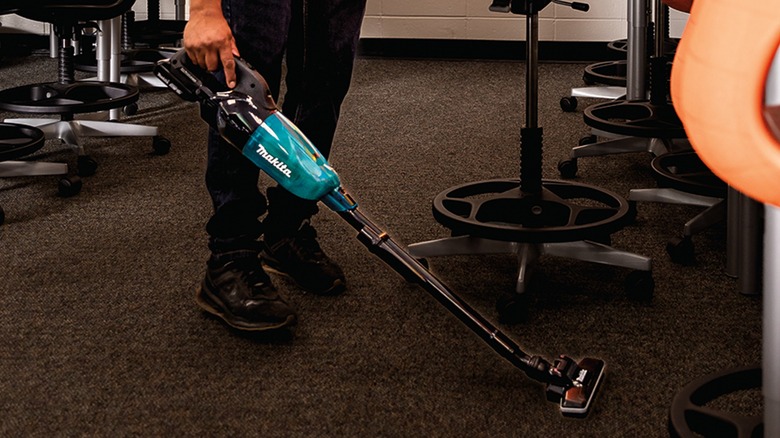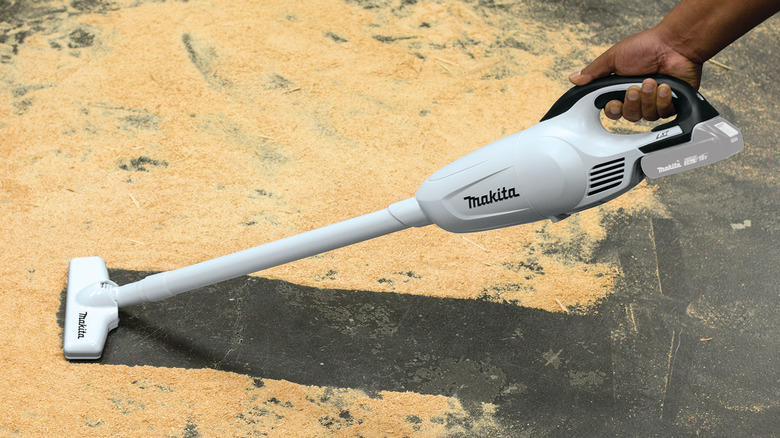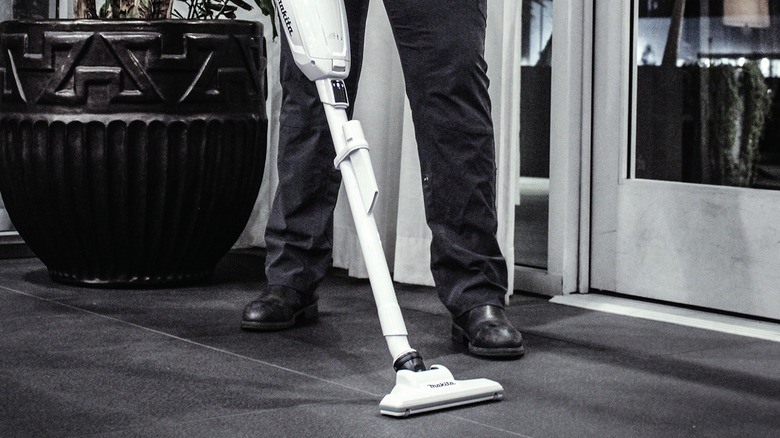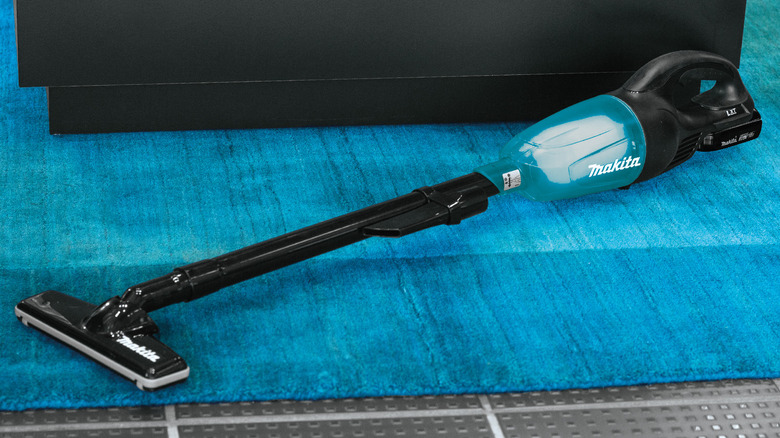Everything You Need To Know About Makita Stick Vacuums Before You Buy
While having a heavy-duty vacuum cleaner at the ready is great for deep cleaning and other big jobs, it can be just as useful to have a smaller stick vacuum waiting in the wings. Not only are stick vacuums far more lightweight and compact, but they're also more portable, allowing users to quickly and easily clean spaces that would be otherwise difficult to reach with traditional vacuum options. Of course, the best of the selection on the market also manages to boast a decent amount of suction power and battery life.
There are plenty of stick vacuums on offer from different brands, though the economically-minded may pay particular attention to those from Makita. Generally speaking, Makita vacuums won't break the bank but still maintain a good level of quality without compromising too far on raw performance or versatility. The manufacturer currently has quite a few different variations in stock as well. With all that in mind, here are the most important things to know about Makita's selection of stick vacuums before making a purchase.
Makita has various stick vacuums to choose from
As Makita has shown with other tool offerings throughout its history, its supply of stick vacuums is comprised of quite a few different models. As it stands, Makita offers more than 20 different stick vacuum sets, all of which are cordless and battery-operated. That number may feel a bit overwhelming, but this set of appliances can be broken down into a few distinct groups.
On the budget end of the spectrum are various options from Makita's LXT line of stick vacuums, the cheapest of which go for around $129.00 from major retailers like Home Depot. These vacuums run off of Makita's 18V LXT series of lithium-ion batteries and offer a fairly no-frills portable vacuum experience, save for a few perks like an optional floor nozzle and a cloth filtration system.
The LXT line then has several mid-range, more pricey variations, such as the LXT Compact, which emphasizes an extra-compact form factor, and the LXT Brushless, which uses an extra-efficient brushless motor. Some listings combine these qualities into the LXT Brushless Compact vacuums but slot in a much more expensive range from $400 to $500.
In addition to Makita's LXT offerings, the company also has the XGT series of vacuums, all of which run on 40V max XGT lithium-ion 2.0Ah batteries. Most of Makita's XGT vacuums are on the more expensive end of the spectrum, running from $300 to over $500, but they make up for it with premium qualities such as superior suction power and a lengthier battery life compared to other options.
There are different levels of suction power on offer
It's important to find handheld stick vacuums that still offer the necessary level of suction power to get cleaning jobs done. The products on offer from Makita feature a fairly wide range of suction power and general performance specs, giving customers plenty of options to choose from.
As you'd expect, the cheaper options in Makita's selection are less powerful than the more expensive ones. For instance, the 18V LXT XLC01ZB vacuum has 30 watts of suction power, an airflow rate of 35 CFM, and a static water lift of 14 inches, according to Makita. These stats are on the lower end of the spectrum for suction power, and a vacuum of this variety is best suited for light cleaning jobs rather than any intensive work. That said, even these more modest offerings should have enough suction power to suffice for typical household vacuuming tasks, with the lower amount of power also allowing for better battery life.
For those who are dead set on getting a stick vacuum with quite a bit of power, some of Makita's more premium offerings may fit the bill. The 18V LXT XLC08R1B vacuum manages 90 watts of suction power, with an airflow rate of 39 CFM, and a static water lift of 70.2 inches. Some units take it even further, like the 40V XGT GLC02Z vacuum, which hits 42 CFM and 84 inches of static water lift when operating at maximum capacity. Suffice to say, these units can offer pretty beefy performance levels for a battery-powered vacuum, even if corded power tools still outpace cordless in most instances.
Battery life is a key consideration
Like many cordless tools, Makita's entire line of stick vacuums relies on lithium-ion battery packs to function. Seeing as assorted units rely on various batteries from the manufacturer, they can also last for a wildly different amount of time. That's why the average amount of continuous runtime is another key factor to consider when picking out a specific model.
In general, the Makita stick vacuums from the LXT Compact series have the shortest runtime. These units rely on 18V LXT Compact lithium-ion 2.0Ah batteries, which are comparatively smaller than other types used in Makita's vacuums. As an example, the 18V LXT XLC02R1B vacuum can only last up to 13 minutes of continuous use on a single charge of its battery, which is a pretty small amount of time. Units powered by the 18V LXT 5.0Ah battery can achieve a more solid runtime of around 33 minutes.
For those who would prefer not to worry as much about constantly recharging their stick vacuum, it's probably best to look at Makita's XGT models. They run on a 40V max XGT 2.0Ah battery and can achieve a continuous runtime of up to 64 minutes — nearly five times as long as some in the 18V LXT Compact line.



